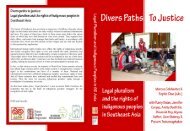The Upper Caura, Venezuela - Forest Peoples Programme
The Upper Caura, Venezuela - Forest Peoples Programme
The Upper Caura, Venezuela - Forest Peoples Programme
You also want an ePaper? Increase the reach of your titles
YUMPU automatically turns print PDFs into web optimized ePapers that Google loves.
Protecting and encouraging customary use of biological resources: <strong>The</strong> <strong>Upper</strong> <strong>Caura</strong>, <strong>Venezuela</strong>_________________________________________________________________________________________Executive SummaryArticle 10c of the Convention on Biological Diversity (CBD) requires countries that are party tothe Convention to ‘protect and encourage the customary use of biological resources inaccordance with traditional cultural practices that are compatible with conservation orsustainable use requirements’. <strong>The</strong> CBD secretariat concludes that governments shouldtherefore ensure national laws and policies secure indigenous peoples’ customary laws, systemsof self-governance and rights over land and other resources. This study examines therequirements for fulfilling these obligations in <strong>Venezuela</strong> through a participatory review of thecustomary uses, traditional practices and legal context of the indigenous peoples of the <strong>Upper</strong><strong>Caura</strong> river in <strong>Venezuela</strong>.<strong>The</strong> <strong>Caura</strong> is a major tributary of the Orinoco. <strong>The</strong> <strong>Caura</strong> basin, though underlain by nutrientpoor rocks and soils, is home to considerable biodiversity. <strong>The</strong> two main ethnic groups in thearea – the Ye’kwana and Sanema – have a long history of occupation of these forests, on whichtheir livelihoods, cultures and identities depend. Although the two peoples have quite distinctlivelihood strategies – the former customarily living in large, long established and widelydispersed villages, the latter being much more mobile and living in scattered hamlets – bothmake extensive use of the forests through shifting cultivation, hunting, fishing and foraging.<strong>The</strong>se customary uses are regulated through a complex web of customary laws and ‘traditionalpractices’ which define gender roles, norms of sharing and exchange, and notions of propertyand territoriality. <strong>The</strong> peoples’ egalitarian customary institutions ensure social equity, definedroles for women and enforce social norms through peer pressure, shared value systems anddefined but non-hierarchical polities. Pressure on resources is slight – the population density islower than 8 km 2 /person – and is reduced further by the traditional practices of rotating the useof defined hunting zones to allow the fauna to recover (Ye’kwana) and moving villagesfrequently (Sanema). Environmental issues are explicitly part of decision-making aboutsettlement siting and resource use.<strong>The</strong> <strong>Venezuela</strong>n State has only a tenuous presence in this isolated upland area, although plans todevelop hydropower and log the area have been shelved rather than dropped. <strong>The</strong> State definesthe whole area as falling within a number of ‘protected areas’ (Areas Bajo Régimen deAdministración Especial’), which technically make indigenous land use illegal – although theserules are not enforced. Historically the <strong>Venezuela</strong>n State has pursued an integrationist policytowards indigenous peoples and, although measures to recognise land rights existed, they werenot widely applied. <strong>The</strong> State ratified the CBD in 1998 and since 2000 the Bolivarian Republic of<strong>Venezuela</strong> has adopted progressive laws and a new Constitution which recognise indigenouspeoples’ rights and allow for the collective titling of their territories (referred to as ‘habitats’).<strong>The</strong>se new laws have yet to applied, however.<strong>The</strong> indigenous peoples of the <strong>Upper</strong> <strong>Caura</strong> have mobilised and organised themselves to asserttheir rights and protect the biological resources of their area by: creating a radio network;establishing a multi-ethnic, basin-wide indigenous association; mapping their customary landuse system; registering their knowledge as their own intellectual property; being the first ethnicgroup to apply for legal title under the new laws; training community members as ‘parabiologists’;carrying out community-level workshops to review their customary institutions;elaborating a draft management plan for the area; calling for the co-management of the existingprotected areas; and building up their own institutional capacity, focused on improvedinterethnic relations and the empowerment of indigenous women.Given that the customary uses and traditional practices of the indigenous peoples of the <strong>Upper</strong><strong>Caura</strong> are clearly ‘compatible with conservation and sustainable use’, the <strong>Venezuela</strong>n State hasonly to apply its existing laws to bring it into full compliance with Article 10c of the CBD. Thiswould be a globally significant act and deserving of international support.1
















